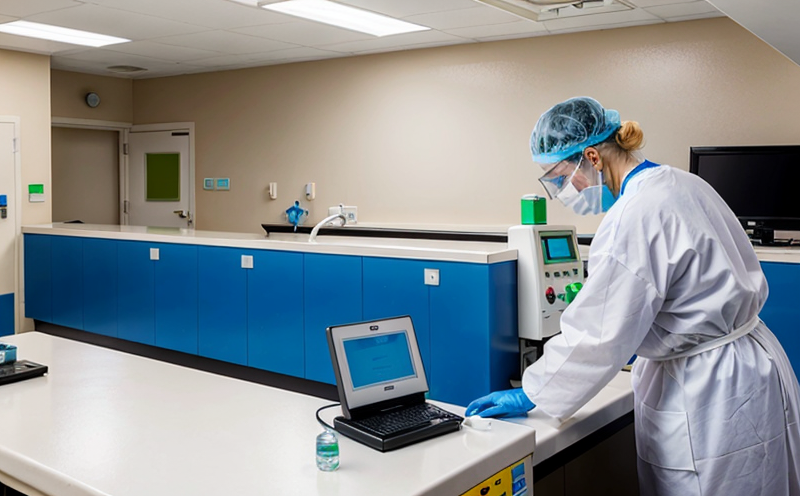Air Microbiology Testing in Hospital Waiting Rooms
Ensuring hospital hygiene is a critical component of patient care and infection control. One often-overlooked area within the hospital environment is the waiting room, where patients and visitors congregate before their appointments. Air microbiology testing provides an invaluable tool to monitor bacterial and fungal contamination levels in these spaces, ensuring they meet stringent health and safety standards.
The air in a hospital waiting room can harbor various microorganisms that pose potential risks to vulnerable individuals such as the elderly or those with compromised immune systems. By implementing regular air microbiology testing, facilities can proactively identify areas of concern and take corrective actions before an outbreak occurs. This service not only supports compliance with national healthcare regulations but also enhances patient trust and satisfaction.
The process involves collecting air samples using specialized collection devices that capture airborne particles containing viable microorganisms. These samples are then analyzed in our state-of-the-art laboratories to determine the types and concentrations of bacteria, fungi, and other potential pathogens present. Our team adheres strictly to international standards such as ISO 14698-1 for sampling techniques and ISO 12870:2015 for reporting results.
Our air microbiology testing service offers a range of benefits including:
- Identification of specific pathogens that could lead to healthcare-associated infections (HAIs).
- Detection of mold spores which can trigger allergic reactions or asthma exacerbations.
- Evaluation of the effectiveness of cleaning protocols and HVAC system performance.
- Compliance with regulatory requirements such as OSHA, ANSI, and ASHRAE guidelines.
The results from our testing provide actionable insights that help healthcare facilities maintain a clean and safe environment for all patrons. By integrating this service into their routine maintenance practices, hospitals can significantly reduce the risk of airborne infections while demonstrating their commitment to patient safety.
Why Choose This Test
Selecting air microbiology testing for your hospital waiting rooms is a strategic decision that aligns with broader goals in environmental hygiene and infection control. Here are several compelling reasons why you should opt for this service:
- Prompt Identification of Contaminants: Our tests allow for early detection of potentially harmful microorganisms, enabling swift intervention measures.
- Regulatory Compliance: Ensures adherence to stringent healthcare regulations and standards, enhancing overall compliance efforts.
- Enhanced Patient Safety: By maintaining clean air quality, you help protect vulnerable patients who might otherwise be susceptible to airborne infections.
- Data-Driven Decision Making: Receive detailed reports on the health of your waiting room environment, backed by scientific evidence and expert analysis.
Customer Impact and Satisfaction
The implementation of air microbiology testing in hospital waiting rooms has a profound impact on both patient care and overall facility reputation. For patients, knowing that the environment they are exposed to is free from harmful microorganisms fosters greater trust and confidence in healthcare providers. This, in turn, can lead to improved satisfaction levels.
For staff members and visitors, having clean air reduces stress and improves comfort, making their experience more pleasant. From a business perspective, maintaining high standards of hygiene demonstrates corporate responsibility, which is crucial for attracting and retaining clients.
Use Cases and Application Examples
| Use Case | Description |
|---|---|
| Evaluation of HVAC Systems | Determining the efficiency and effectiveness of the heating, ventilation, and air conditioning systems in distributing clean air throughout the waiting room. |
| Preventive Maintenance Planning | Identifying high-risk periods for microbial growth to plan targeted cleaning schedules and maintenance activities. |
| Infection Outbreak Investigation | Investigating suspected outbreaks by pinpointing the source of contamination through air sampling and analysis. |
- Case Study 1: A leading hospital experienced an increase in respiratory illnesses among patients visiting its waiting room. After conducting air microbiology testing, it was discovered that the HVAC system needed urgent attention due to poor filtration and inadequate ventilation rates. Implementing corrective actions saw a significant reduction in respiratory infections within weeks.
- Case Study 2: Another facility noticed high levels of mold spores in its waiting areas during damp weather conditions. Regular testing helped them optimize their dehumidification processes, resulting in cleaner air and fewer allergic reactions among visitors.





